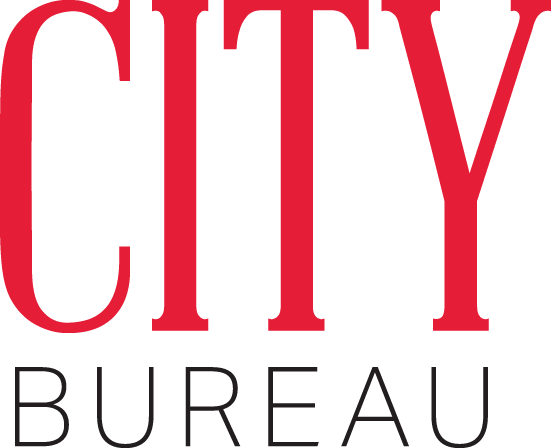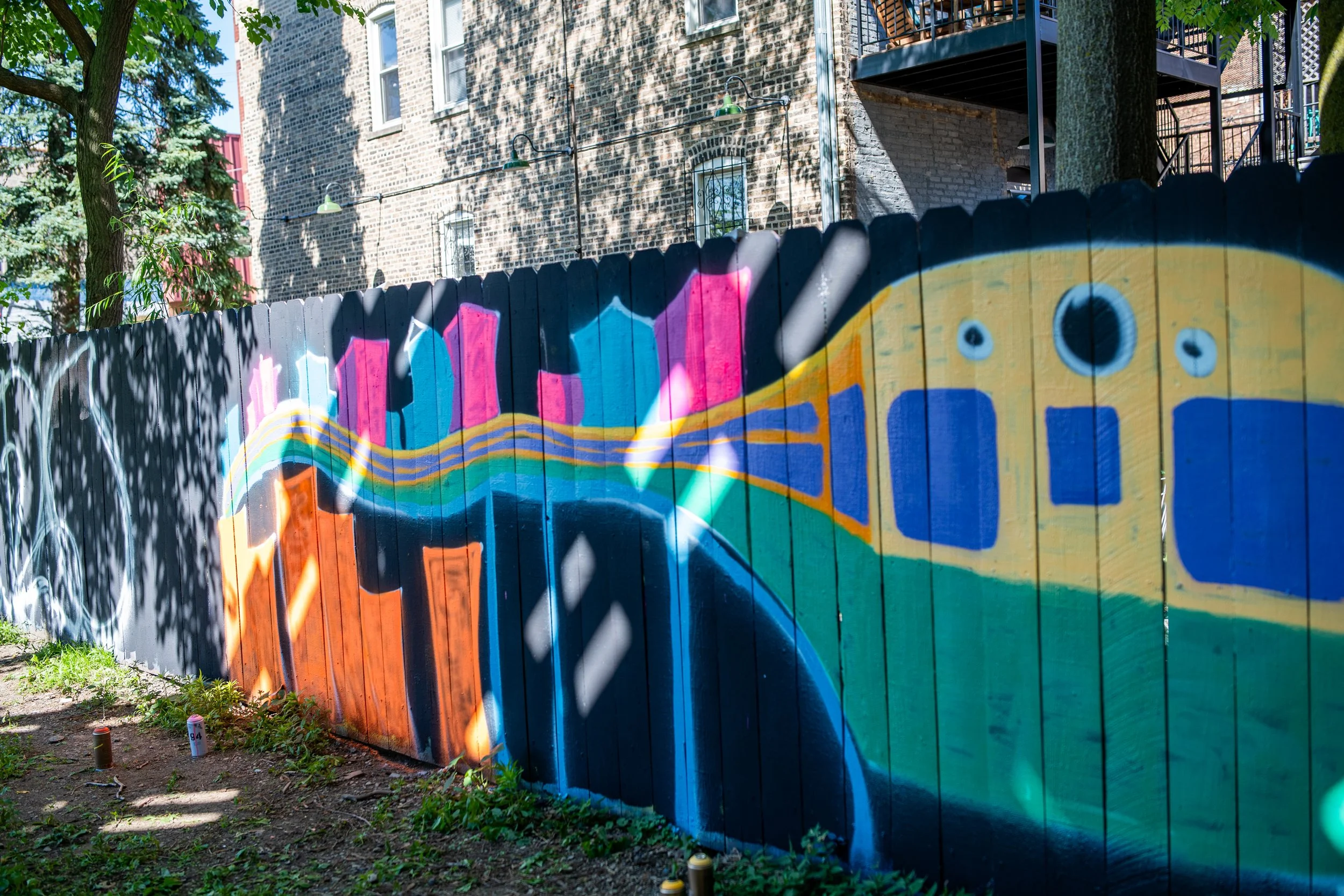With roots on the West Side and a love for city transit, Ahmed Burson has turned walls into vibrant reflections of Chicago’s culture and community — one spray can at a time.
By Robyn Meurkson
Muralists Ahmed and Icy Burson pose for a photo at the Against the Fence one-day art fest on Saturday, June 28, 2025, in Logan Square. (Peyton Reich/for City Bureau).
In the heart of a city known for its vibrant history and creativity, 37-year-old Ahmed Burson is redefining what public art means for Chicago’s neighborhoods.
Inspired by family roots in the city’s transit system, and a passion for honoring local history, Burson has painted murals that brighten walls, spark conversations, invite community participation and evoke the city’s layered past. Whether teaching a curious child how to use a spray can or collaborating with other artists, Burson’s work is a testament to the belief that art should be for everyone rooted in a place they call home.
He collaborates with his wife, Icy Burson, to transform brick walls and metal gates into vibrant tributes to the city’s history, while defying expectations of who gets to be called an artist. Burson's art is often whimsical, sending messages youth can see and feel. Despite the political undertones, his biggest message is to just be yourself.
He also has collaborated with AnySquared, an intergenerational, inclusive open arts collective to help creators create, learn and collaborate with other artists. The non-profit partnered with Renegades of Funk to organize June’s Against Da Fence one-day art fest at Project Logan, where the Bursons were among dozens of contributing artists.
Burson reflected on his journey into Chicago’s mural scene and his hopes for using art as a tool for connection, visibility and youth empowerment.
This interview has been edited and condensed for clarity.
Muralist Ahmed Burson starts his mural at the Against the Fence one-day art fest on Saturday, June 28, 2025, in Logan Square. (Peyton Reich/for City Bureau)
How did you get into mural painting?
It was my guy, Flash. Flash is one of the early prolific graffiti writers in the Chicago area. He originates out of Logan Square. I met him at [a Chicago hip-hop heritage event ] at Columbia [College] back in 2019, and they were doing film screenings for classic hip-hop films. I showed them my artwork, and Flash has taken a very strong liking to it, because my artwork was pretty much depicting vintage Chicago. The CTA buses and trains were originally green and white, from the 1960s, 70s, and 80s. The following year, I was part of [Project Logan]. I literally had just put my art out there for the very first time.
[Project Logan] was actually an entire one square block of an abandoned mechanic shop that had been gutted by fire, but the walls and the structure of it still stood. You would come down, and you would show your stuff, and your work was up there. Basically, like an art gallery.
What inspired your interest in Chicago's public transportation?
My parents both started out at the Chicago Transit Authority. If my grandma or cousins couldn’t babysit us, I would go to work with them. I remember riding the Blue Island bus with my mom, just watching the Orange Line train arriving while drinking orange juice and having some potato chips. Some of the many memories I have are riding the Kedzie and California buses with my dad, or riding the Blue Island and Pulaski buses with my mother.
The start of a CTA train mural by muralists Ahmed and Icy Burson at the Against the Fence one-day art fest. (Peyton Reich/for City Bureau).
Can you explain your design process?
It should start out as a design, so you’ll have an idea of what you're going to paint. Then, you can map it and lay it out. The very first time we chose to do an image was of a green limousine. With the help, and with the assistance from my wife and with our mentors — Flash, Dollars, BboyB’s advice — they taught us how to use a spray can, how to use the caps for the spray can, and how to release the pressure from the spray can, so that you can have more control of the spray as it comes out of the can. It took us a good two months to actually complete the mural. For our first mural, it was definitely the fact that there are different types of caps that will either fatten the spray or thin the spray.
Can you share an example where a mural positively impacted the youth involved?
In several different instances, neighborhood kids came by the wall and saw us painting and were naturally curious. I showed them how to use a spray can, and how to properly and safely use it, and showed them how to lay down color, line work and fillers.
A little boy plays with spray paint at the Against the Fence one-day art fest. (Peyton Reich/for City Bureau)
What youth programs does AnySquared offer for emerging young artists?
AnySquared has sessions every Wednesday, Friday, and on certain Sundays for the youth to come by and create art. It is a melting pot of artists collaborating together and networking from teenage and up. Artists can paint anything that comes to their creative mind: flowers, sea creatures, graffiti, etc. They have other events such as tutorial classes for crafting, music, poetry and others. Everyone is welcome to come as they are!
What advice do you have for youth about summer opportunities, work and entrepreneurship?
Get involved and make sure you have the right mentors. Summer opportunities can open the doors to other opportunities in mentorship, entrepreneurship, and could take you places you've never imagined.
Would you encourage young people to become entrepreneurs?
I would encourage this: Hone your craft and skills first, and listen to those who have your best interests at heart, and the doors to being an entrepreneur will open.
Support City Bureau’s Civic Reporting fellowship by becoming a recurring donor.
Check back later to see more of our fellows’ work on youth and summer opportunity.




